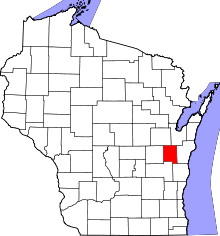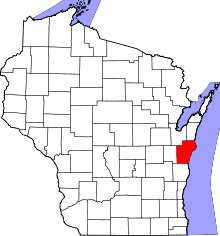Kiel, Wisconsin
| Kiel, Wisconsin | |
|---|---|
| City | |
|
Kiel City Hall | |
 Location of Kiel, Wisconsin | |
| Coordinates: 43°54′53″N 88°1′55″W / 43.91472°N 88.03194°WCoordinates: 43°54′53″N 88°1′55″W / 43.91472°N 88.03194°W | |
| Country | United States |
| State | Wisconsin |
| Counties | Manitowoc, Calumet |
| Area[1] | |
| • Total | 2.67 sq mi (6.92 km2) |
| • Land | 2.53 sq mi (6.55 km2) |
| • Water | 0.14 sq mi (0.36 km2) |
| Elevation[2] | 919 ft (280 m) |
| Population (2010)[3] | |
| • Total | 3,738 |
| • Estimate (2012[4]) | 3,696 |
| • Density | 1,477.5/sq mi (570.5/km2) |
| Time zone | Central (CST) (UTC-6) |
| • Summer (DST) | CDT (UTC-5) |
| Area code(s) | 920 |
| FIPS code | 55-39525[5] |
| GNIS feature ID | 1567461[2] |
| Website |
www |
Kiel is a city in Calumet and Manitowoc counties in the U.S. state of Wisconsin. The population was 3,738 at the 2010 census. Of this, 3,429 were in Manitowoc County, and 309 were in Calumet County. The city is located mostly within Manitowoc County, though a portion extends west into adjacent Calumet County.
It was once known as the "Wooden Shoes" Capital of Wisconsin as it held the only wooden shoes factory in Wisconsin.[6]
History
Charley Lindemann immigrated to the area and began a settlement among the Native American Menominee and Potawatomi tribes.[7] His wife named the community after her home town of Kiel, Germany.[7] Two years later, Col. Henry F. Belitz, later nicknamed the "Father of Kiel", built a hotel and mill along the north side of the Sheboygan River.[7] A road was built across Wisconsin to connect Green Bay with Milwaukee area communities.[7] The bridge was built across the Sheboygan River in 1858 connecting Kiel with Sheboygan.[7] In the late nineteenth century to the early twentieth century, Kiel became a manufacturing area with businesses specializing in brick, wood shoes, machine, and furniture manufacturing.[7]
Geography
Kiel is located at 43°54′53″N 88°1′55″W / 43.91472°N 88.03194°W (43.914718, -88.031812),[8] along the Sheboygan River.
According to the United States Census Bureau, the city has a total area of 2.67 square miles (6.92 km2), of which, 2.53 square miles (6.55 km2) is land and 0.14 square miles (0.36 km2) is water.[1]
Demographics
| Historical population | |||
|---|---|---|---|
| Census | Pop. | %± | |
| 1880 | 363 | — | |
| 1890 | 497 | 36.9% | |
| 1900 | 924 | 85.9% | |
| 1910 | 1,244 | 34.6% | |
| 1920 | 1,599 | 28.5% | |
| 1930 | 1,803 | 12.8% | |
| 1940 | 1,898 | 5.3% | |
| 1950 | 2,129 | 12.2% | |
| 1960 | 2,524 | 18.6% | |
| 1970 | 2,848 | 12.8% | |
| 1980 | 3,083 | 8.3% | |
| 1990 | 2,910 | −5.6% | |
| 2000 | 3,450 | 18.6% | |
| 2010 | 3,738 | 8.3% | |
| Est. 2015 | 3,719 | [9] | −0.5% |
2010 census

As of the census[3] of 2010, there were 3,738 people, 1,565 households, and 1,021 families residing in the city. The population density was 1,477.5 inhabitants per square mile (570.5/km2). There were 1,697 housing units at an average density of 670.8 per square mile (259.0/km2). The racial makeup of the city was 96.9% White, 0.4% African American, 0.6% Native American, 0.6% Asian, 0.7% from other races, and 0.8% from two or more races. Hispanic or Latino of any race were 2.0% of the population.
There were 1,565 households of which 33.0% had children under the age of 18 living with them, 53.4% were married couples living together, 8.1% had a female householder with no husband present, 3.8% had a male householder with no wife present, and 34.8% were non-families. 29.9% of all households were made up of individuals and 13.8% had someone living alone who was 65 years of age or older. The average household size was 2.39 and the average family size was 2.98.
The median age in the city was 38.7 years. 26.5% of residents were under the age of 18; 5.3% were between the ages of 18 and 24; 27.6% were from 25 to 44; 25% were from 45 to 64; and 15.7% were 65 years of age or older. The gender makeup of the city was 48.0% male and 52.0% female.
2000 census
As of the census[5] of 2000, there were 3,450 people, 1,425 households, and 940 families residing in the city. The population density was 1,433.9 people per square mile (552.7/km²). There were 1,498 housing units at an average density of 622.6 per square mile (240.0/km²). The racial makeup of the city was 98.58% White, 0.06% African American, 0.23% Native American, 0.46% Asian, 0.23% from other races, and 0.43% from two or more races. Hispanic or Latino of any race were 0.72% of the population.
There were 1,425 households out of which 32.2% had children under the age of 18 living with them, 56.1% were married couples living together, 7.1% had a female householder with no husband present, and 34.0% were non-families. 30.0% of all households were made up of individuals and 14.2% had someone living alone who was 65 years of age or older. The average household size was 2.42 and the average family size was 3.04.
In the city the population was spread out with 26.4% under the age of 18, 7.8% from 18 to 24, 30.3% from 25 to 44, 19.7% from 45 to 64, and 15.8% who were 65 years of age or older. The median age was 36 years. For every 100 females there were 91.8 males. For every 100 females age 18 and over, there were 90.1 males.
The median income for a household in the city was $44,239, and the median income for a family was $53,798. Males had a median income of $36,576 versus $27,070 for females. The per capita income for the city was $23,112. About 1.7% of families and 2.7% of the population were below the poverty line, including 1.6% of those under age 18 and 2.7% of those age 65 or over.
Transportation
Wisconsin Highway 67 run north/south at the extreme east edge of Kiel. Highways 32 and 57 run through downtown Kiel, entering the city from the north at the northwest corner of the city and enter from the east at the southeast corner of the city. Wisconsin Highway 149 originally had its western terminus in Kiel. It later was extended west to Fond du Lac. Many years later the original route from Cleveland to Kiel was decommissioned and the eastern terminus of the highway was located in Kiel. The entire route was decommissioned in the 2000s.
The Sheboygan River enters the city in the south edge of the city, runs through downtown, and exits the city in the east side of the city. The river is rarely used as a means of transportation. There is a dam in downtown Kiel and another one several miles downstream in Millhome.
Kiel is served by the Wisconsin and Southern Railroad. Historically this line was built by the Milwaukee Road.
Businesses
Notable natives and residents
- Trevor Casper, former Wisconsin State Trooper
Images
 Welcome sign
Welcome sign
 The Sheboygan River in winter
The Sheboygan River in winter Post Office
Post Office Kiel Public Library
Kiel Public Library
References
- 1 2 "US Gazetteer files 2010". United States Census Bureau. Retrieved 2012-11-18.
- 1 2 "US Board on Geographic Names". United States Geological Survey. 2007-10-25. Retrieved 2008-01-31.
- 1 2 "American FactFinder". United States Census Bureau. Retrieved 2012-11-18.
- ↑ "Population Estimates". United States Census Bureau. Retrieved 2013-06-24.
- 1 2 "American FactFinder". United States Census Bureau. Retrieved 2008-01-31.
- ↑ Lauson, Richard (January 19, 1925). "State's First and Only Wooden Shoe Factory Still Operating in Kiel". Wisconsin State Journal. Retrieved 18 May 2010.
- 1 2 3 4 5 6 "Term: Kiel [brief history]". Wisconsin Historical Society. Retrieved February 17, 2014.
- ↑ "US Gazetteer files: 2010, 2000, and 1990". United States Census Bureau. 2011-02-12. Retrieved 2011-04-23.
- ↑ "Annual Estimates of the Resident Population for Incorporated Places: April 1, 2010 to July 1, 2015". Retrieved July 2, 2016.
- ↑ "Census of Population and Housing". Census.gov. Retrieved June 4, 2015.
External links
| Wikimedia Commons has media related to Kiel, Wisconsin. |
- City of Kiel
- Kiel Area Association of Commerce.
- Sanborn fire insurance maps: 1894 1900 1911


